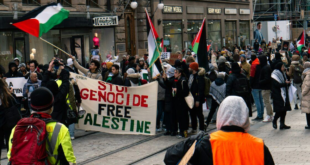BAGHDAD (AFP) — The genocide trial of Saddam Hussein heard its penultimate witness Monday in a sign it will soon concentrate on documents allegedly linking former Iraqi authorities to the 1988 massacres of Kurds.
The trial, which began on August 21, has heard more than 70 witnesses, mostly victims of the brutal Iraqi anti-insurgency campaign that swept through the country’s Kurdish provinces at the tail end of its war with Iran.
Judge Mohammad Oreibi Khalifah agreed to a prosecution request to conclude the witness phase of the trial, and the penultimate witness testified on the so-called Anfal military campaign.
But before the final witness was called the trial was abruptly adjourned to Wednesday.
The court heard lengthy testimony from Abdel Qader Abdullah, a former peshmerga (Kurdish guerrilla) who lost 22 members of his family in a gas attack.
“I saw a woman lying on her face near a stream,” he said. “When I turned her over I discovered she was my mother. I wanted to kiss her, but I knew I could be infected by the chemicals.
“I wasn’t even able to kiss her goodbye,” he said, breaking into tears.
Abdullah described how he searched the darkened village by flashlight, only to find his wife sick and vomiting and his two young daughters dead.
He was able to save his wife and then later his brother and father by giving them atropine injections.
Saddam and his six co-defendants are accused of killing 182,000 Kurds in 1988 when government troops suppressed a Kurdish uprising with artillery, air strikes and poison gas attacks.
Saddam and his cousin Ali Hassan Majid are the only two defendants specifically charged with genocide.
On Sunday, Saddam’s lawyers submitted appeals against his November 5 death sentence, as well as those of fellow defendants, in the previous Dujail trial over the execution of 148 Shiites in the early 1980s.
Prime Minister Nuri Maliki has said previously he expected Saddam to be hanged before the end of the year.
Last week, expert witnesses presented the technical details of how Saddam’s forces attacked the Kurdish people during the Anfal campaign.
Thursday’s session heard harrowing testimony from American expert Michael Trimble, who explained how three mass graves discovered since the March 2003 US invasion of Iraq were filled mainly with the bullet-riddled corpses of very young children.
Of 301 bodies in the graves, 183 were Kurdish children killed during the Anfal campaign, said Trimble, who heads the mass graves investigation unit at the Iraqi high tribunal.
“The captives were often bound and blindfolded. The captives were led into the grave and then executed with pistols or automatic assault rifle fire. The graves were then covered by those directing the execution,” Trimble said.
“In all these graves, 90 per cent of the children are less than 13 years of age,” he said, adding that one was a child of six to 12 months, “shot in the back of his head as his mother held him in her arms”.
Trimble said “it was a highly organised programme of execution”.
On Monday, former army commander Sultan Hashim Taie disputed Trimble’s testimony, suggesting that he was biased.
“We need an expert from a neutral country,” he told the court.
“We were officers, we carried out our duty. We fought the Iranians, we didn’t kill civilians.” The trial’s next phase, expected to start in a matter of days, will feature documentary evidence allegedly linking Saddam and his co-accused to the attacks on Kurds.
According to the former regime, the Anfal campaign was a legitimate counterinsurgency operation against Kurdish separatists at a time when Iraq was at war with neighbouring Iran.
 Eurasia Press & News
Eurasia Press & News

